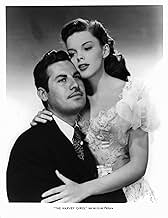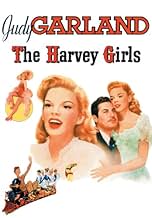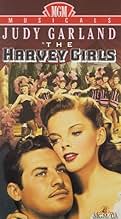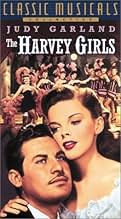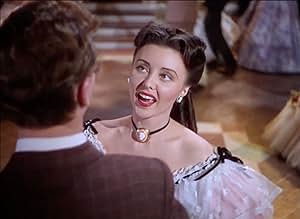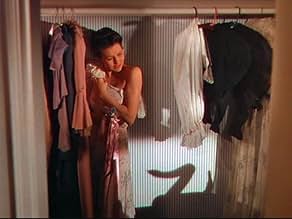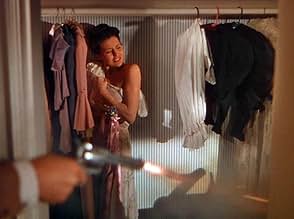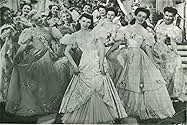ÉVALUATION IMDb
7,0/10
5,2 k
MA NOTE
Lors d'un voyage en train vers l'Ouest pour se marier à un homme qu'elle ne connaît pas, Susan Bradley rencontre une joyeuse équipe de jeunes femmes qui voyagent pour ouvrir un restaurant da... Tout lireLors d'un voyage en train vers l'Ouest pour se marier à un homme qu'elle ne connaît pas, Susan Bradley rencontre une joyeuse équipe de jeunes femmes qui voyagent pour ouvrir un restaurant dans une gare perdue.Lors d'un voyage en train vers l'Ouest pour se marier à un homme qu'elle ne connaît pas, Susan Bradley rencontre une joyeuse équipe de jeunes femmes qui voyagent pour ouvrir un restaurant dans une gare perdue.
- A remporté 1 oscar
- 4 victoires et 1 nomination au total
William 'Bill' Phillips
- 1st Cowboy
- (as Wm. 'Bill' Phillips)
Avis en vedette
Even though the film starred Judy Garland, what I really enjoyed about The Harvey Girls is that it operates as an ensemble musical, giving features and spotlight numbers to just about everyone in the mammoth cast. This kind of thing is usually reserved for stage musicals only, but back in 1946 MGM's roster of talent was strong, if not yet infamous. Players like deadpan comic Virginia O'Brien and dancer Cyd Charisse were fairly new back then, but this film gives them individual spotlights: not only do they both sing with Garland in the nighttime ballad "It's A Great Big World," but O'Brien gets to sing "The Wild, Wild West" (while assisting blacksmith Ray Bolger in shoeing a horse) and Charisse gets to dance (briefly) opposite Kenny Baker singing "Wait And See." Marjorie Main leads the Harvey waitresses through "The Train Must Be Fed;" Angela Lansbury is featured in two saloon numbers, and Ray Bolger gets to do some of his rubber-legged clowning at the Harvey House party. And, of course, everyone on the planet is assembled for the big, eight minute production number "On The Atchison, Topeka, and Santa Fe." There's literally something for everyone- even the oil-and-water romance between Garland and John Hodiak. And they shine as well, even if Hodiak wasn't the most well-known leading man. Check out this wonderfully scored, written, acted, and costumed tribute to old-fashioned Americana.
As a lover of musicals and of Judy Garland, I watched The Harvey Girls and I really liked it on the whole. The plot though is cardboard especially in the second half and John Hodiak for my liking gives a rather lacklustre performance. Still it is worth seeing. The film with its beautiful costumes, scenery and photography does look gorgeous, the music is fantastic particularly the climatic set-piece On the Atchison, Topeka and The Santa Fe, the choreography is magnificent and the first half is great fun. The film is directed lovingly by George Sidney, and while Angela Lansbury and Ray Bolger are excellent, this is Judy Garland's film and she is absolutely wonderful. Overall, a lovely film. 8/10 Bethany Cox
"The Harvey Girls" is a splendid example of a well-crafted Metro-Goldwyn-Mayer musical from a time when well-crafted musicals were being dished out in abundance from Metro's golden bowl.
Inspired by the revolutionary success of "Oklahoma" on Broadway and tailored to fit the protean talents of it's young leading lady, Judy Garland, the film tells the story, in words and music, of a group of waitresses brought west in the late 1800's to open another link in the Fred Harvey chain of restaurants. In the process, they encounter all kinds of romantic and dramatic conflicts. The cast is headed by Judy Garland, fresh from her triumph in the blockbuster musical "Meet Me In St. Louis" and her quietly moving dramatic performance in "The Clock". During the filming of "The Harvey Girls", Garland was one of the top box-office draws in the nation, and Hollywood's most versatile actress. She performs the role of Susan Bradley, an adventurous mail order bride who befriends the Harvey girls en route to New Mexico, with a vibrant comic touch. Her ability to combine tongue in cheek humor with her signature vulnerability is very satisfying in this film, and is an early highlight in her already legendary career.
The rest of the cast is first-rate: Angela Lansbury gives a wickedly fine performance as Em, the jaded dance-hall queen with hooded eyes and no-flies-on-me attitude. John Hodiak is the local tough guy and dance-hall owner, and also the object of Garland and Lansbury's affections. Broadway legend (and Garland's "Wizard of Oz" co-star) Ray Bolger does an amusing turn as the town's rubber legged blacksmith, and Preston Foster is the murderous Judge Purvis. The ranks of the Harvey girls are filled by some of Hollywood's most marvelous character actresses, including Marjorie Main and Virginia O'Brien, and the dancer Cyd Charisse in one of her first roles.
The film boasts what New York Times film critic Bosley Crowther appreciatively called "an abundance of chromatic spectacle and an uncommonly good score", the centerpiece of which is the Academy Award-winning song of the year (1946), "On The Atchison, Topeka, and the Santa Fe". This production number fills the screen with the colorful bustle of singers, dancers, and horses, and in the best Broadway tradition, advances the plot by introducing almost every cast member and giving them the opportunity to tell their story, in song, and their motivation for coming west in the first place. A spectacular bit of Golden Age musical magic, topped off by Garland's star turn entrance and full-throated belting of the Johnny Mercer/Harry Warren song.
The creative team behind this fable is as impressive as the talent in front of the camera. In addition to the score by Mercer and Warren, the film was directed by George Sidney ("Show Boat", "Annie Get Your Gun"), produced by Arthur Freed ("Singin In The Rain", "Gigi"), art directed by Cedric Gibbons ("The Great Zeigfeld", "The Wizard of Oz"), with musical direction by Lennie Hayton, orchestrations by Conrad Salinger, and musical arrangements by "Eloise" children's book author and singer Kay Thompson (a decade before she sizzled onscreen as the fashion magazine editor in the Audrey Hepburn classic "Funny Face").
This film will include restored Technicolor and stereo sound on DVD, and also a few musical numbers which were cut when the film was released due to length, and have been locked away in the MGM vaults. Now they have been restored, and the viewer can enjoy more of what film critic Howard Barnes called "a great big animated picture postcard."
Inspired by the revolutionary success of "Oklahoma" on Broadway and tailored to fit the protean talents of it's young leading lady, Judy Garland, the film tells the story, in words and music, of a group of waitresses brought west in the late 1800's to open another link in the Fred Harvey chain of restaurants. In the process, they encounter all kinds of romantic and dramatic conflicts. The cast is headed by Judy Garland, fresh from her triumph in the blockbuster musical "Meet Me In St. Louis" and her quietly moving dramatic performance in "The Clock". During the filming of "The Harvey Girls", Garland was one of the top box-office draws in the nation, and Hollywood's most versatile actress. She performs the role of Susan Bradley, an adventurous mail order bride who befriends the Harvey girls en route to New Mexico, with a vibrant comic touch. Her ability to combine tongue in cheek humor with her signature vulnerability is very satisfying in this film, and is an early highlight in her already legendary career.
The rest of the cast is first-rate: Angela Lansbury gives a wickedly fine performance as Em, the jaded dance-hall queen with hooded eyes and no-flies-on-me attitude. John Hodiak is the local tough guy and dance-hall owner, and also the object of Garland and Lansbury's affections. Broadway legend (and Garland's "Wizard of Oz" co-star) Ray Bolger does an amusing turn as the town's rubber legged blacksmith, and Preston Foster is the murderous Judge Purvis. The ranks of the Harvey girls are filled by some of Hollywood's most marvelous character actresses, including Marjorie Main and Virginia O'Brien, and the dancer Cyd Charisse in one of her first roles.
The film boasts what New York Times film critic Bosley Crowther appreciatively called "an abundance of chromatic spectacle and an uncommonly good score", the centerpiece of which is the Academy Award-winning song of the year (1946), "On The Atchison, Topeka, and the Santa Fe". This production number fills the screen with the colorful bustle of singers, dancers, and horses, and in the best Broadway tradition, advances the plot by introducing almost every cast member and giving them the opportunity to tell their story, in song, and their motivation for coming west in the first place. A spectacular bit of Golden Age musical magic, topped off by Garland's star turn entrance and full-throated belting of the Johnny Mercer/Harry Warren song.
The creative team behind this fable is as impressive as the talent in front of the camera. In addition to the score by Mercer and Warren, the film was directed by George Sidney ("Show Boat", "Annie Get Your Gun"), produced by Arthur Freed ("Singin In The Rain", "Gigi"), art directed by Cedric Gibbons ("The Great Zeigfeld", "The Wizard of Oz"), with musical direction by Lennie Hayton, orchestrations by Conrad Salinger, and musical arrangements by "Eloise" children's book author and singer Kay Thompson (a decade before she sizzled onscreen as the fashion magazine editor in the Audrey Hepburn classic "Funny Face").
This film will include restored Technicolor and stereo sound on DVD, and also a few musical numbers which were cut when the film was released due to length, and have been locked away in the MGM vaults. Now they have been restored, and the viewer can enjoy more of what film critic Howard Barnes called "a great big animated picture postcard."
Very appealing MGM musical with wonderful songs, colorful production, Judy Garland at the peak of her feisty charms. In the burgeoning days of train transportation, women are needed to work the eateries scattered throughout the Southwest; in a small New Mexico town, Judy decides to ditch her mail-order marriage for a waitressing job, but she soon finds love again. "On The Atchinson, Topeka and The Santa Fe" won a Best Song Oscar, and deservedly so; this grand number gets the full treatment, and is so exuberantly staged it becomes a classic by itself. The picture does runs short of ideas and inspiration near the end, leading to a poorly-staged romantic finale, yet the supporting cast is excellent, particularly Angela Lansbury as a jealous showgirl. *** from ****
"The Harvey Girls" is a splendid example of a well-crafted Metro-Goldwyn-Mayer musical from a time when well-crafted musicals were being dished out in abundance from Metro's golden bowl.
Inspired by the revolutionary success of "Oklahoma" on Broadway and tailored to fit the protean talents of it's young leading lady, Judy Garland, the film tells the story, in words and music, of a group of waitresses brought west in the late 1800's to open another link in the Fred Harvey chain of restaurants. In the process, they encounter all kinds of romantic and dramatic conflicts.
The cast is headed by Judy Garland, fresh from her triumph in the blockbuster musical "Meet Me In St. Louis" and her quietly moving dramatic performance in "The Clock". During the filming of "The Harvey Girls", Garland was one of the top box-office draws in the nation, and Hollywood's most versatile actress. She performs the role of Susan Bradley, an adventurous mail order bride who befriends the Harvey girls en route to New Mexico, with a vibrant comic touch. Her ability to combine tongue in cheek humor with her signature vulnerability is very satisfying in this film, and is an early highlight in her already legendary career.
The rest of the cast is first-rate: Angela Lansbury gives a wickedly fine performance as Em, the jaded dance-hall queen with hooded eyes and no-flies-on-me attitude. John Hodiak is the local tough guy and dance-hall owner, and also the object of Garland and Lansbury's affections. Broadway legend (and Garland's "Wizard of Oz" co-star) Ray Bolger does an amusing turn as the town's rubber legged blacksmith, and Preston Foster is the murderous Judge Purvis. The ranks of the Harvey girls are filled by some of Hollywood's most marvelous character actresses, including Marjorie Main and Virginia O'Brien, and the dancer Cyd Charisse in one of her first roles.
The film boasts what New York Times film critic Bosley Crowther appreciatively called "an abundance of chromatic spectacle and an uncommonly good score", the centerpiece of which is the Academy Award-winning song of the year (1946), "On The Atchison, Topeka, and the Santa Fe". This production number fills the screen with the colorful bustle of singers, dancers, and horses, and in the best Broadway tradition, advances the plot by introducing almost every cast member and giving them the opportunity to tell their story, in song, and their motivation for coming west in the first place. A spectacular bit of Golden Age musical magic, topped off by Garland's star turn entrance and full-throated belting of the Johnny Mercer/Harry Warren song.
The creative team behind this fable is as impressive as the talent in front of the camera. In addition to the score by Mercer and Warren, the film was directed by George Sidney ("Show Boat", "Annie Get Your Gun"), produced by Arthur Freed ("Singin In The Rain", "Gigi"), art directed by Cedric Gibbons ("The Great Zeigfeld", "The Wizard of Oz"), with musical direction by Lennie Hayton, orchestrations by Conrad Salinger, and musical arrangements by "Eloise" children's book author and singer Kay Thompson (a decade before she sizzled onscreen as the fashion magazine editor in the Audrey Hepburn classic "Funny Face").
This film will include restored Technicolor and stereo sound on DVD, and also a few musical numbers which were cut when the film was released due to length, and have been locked away in the MGM vaults. Now they have been restored, and the viewer can enjoy more of what film critic Howard Barnes called "a great big animated picture postcard."
Inspired by the revolutionary success of "Oklahoma" on Broadway and tailored to fit the protean talents of it's young leading lady, Judy Garland, the film tells the story, in words and music, of a group of waitresses brought west in the late 1800's to open another link in the Fred Harvey chain of restaurants. In the process, they encounter all kinds of romantic and dramatic conflicts.
The cast is headed by Judy Garland, fresh from her triumph in the blockbuster musical "Meet Me In St. Louis" and her quietly moving dramatic performance in "The Clock". During the filming of "The Harvey Girls", Garland was one of the top box-office draws in the nation, and Hollywood's most versatile actress. She performs the role of Susan Bradley, an adventurous mail order bride who befriends the Harvey girls en route to New Mexico, with a vibrant comic touch. Her ability to combine tongue in cheek humor with her signature vulnerability is very satisfying in this film, and is an early highlight in her already legendary career.
The rest of the cast is first-rate: Angela Lansbury gives a wickedly fine performance as Em, the jaded dance-hall queen with hooded eyes and no-flies-on-me attitude. John Hodiak is the local tough guy and dance-hall owner, and also the object of Garland and Lansbury's affections. Broadway legend (and Garland's "Wizard of Oz" co-star) Ray Bolger does an amusing turn as the town's rubber legged blacksmith, and Preston Foster is the murderous Judge Purvis. The ranks of the Harvey girls are filled by some of Hollywood's most marvelous character actresses, including Marjorie Main and Virginia O'Brien, and the dancer Cyd Charisse in one of her first roles.
The film boasts what New York Times film critic Bosley Crowther appreciatively called "an abundance of chromatic spectacle and an uncommonly good score", the centerpiece of which is the Academy Award-winning song of the year (1946), "On The Atchison, Topeka, and the Santa Fe". This production number fills the screen with the colorful bustle of singers, dancers, and horses, and in the best Broadway tradition, advances the plot by introducing almost every cast member and giving them the opportunity to tell their story, in song, and their motivation for coming west in the first place. A spectacular bit of Golden Age musical magic, topped off by Garland's star turn entrance and full-throated belting of the Johnny Mercer/Harry Warren song.
The creative team behind this fable is as impressive as the talent in front of the camera. In addition to the score by Mercer and Warren, the film was directed by George Sidney ("Show Boat", "Annie Get Your Gun"), produced by Arthur Freed ("Singin In The Rain", "Gigi"), art directed by Cedric Gibbons ("The Great Zeigfeld", "The Wizard of Oz"), with musical direction by Lennie Hayton, orchestrations by Conrad Salinger, and musical arrangements by "Eloise" children's book author and singer Kay Thompson (a decade before she sizzled onscreen as the fashion magazine editor in the Audrey Hepburn classic "Funny Face").
This film will include restored Technicolor and stereo sound on DVD, and also a few musical numbers which were cut when the film was released due to length, and have been locked away in the MGM vaults. Now they have been restored, and the viewer can enjoy more of what film critic Howard Barnes called "a great big animated picture postcard."
Le saviez-vous
- AnecdotesIn the big production number "On the Atchison, Topeka and the Santa Fe," from Judy Garland's entrance until the conductor's "All aboard!" was done in one take. Legend has it that they shot it twice and Garland was dead-on move for move both times.
- GaffesIn the "Wild, Wild West" song, Alma is pounding a red-hot horseshoe. She then picks it up, caresses it, and throws it in the water barrel where it gives off steam. The horseshoe would have burned her hand if it were really hot. This is a sight gag in the film.
- ConnexionsFeatured in MGM Parade: Episode #1.25 (1955)
- Bandes originalesIn the Valley (Where the Evenin' Sun Goes Down)
(uncredited)
Music by Harry Warren
Lyrics by Johnny Mercer
Performed by Judy Garland
Meilleurs choix
Connectez-vous pour évaluer et surveiller les recommandations personnalisées
Détails
- Date de sortie
- Pays d’origine
- Langue
- Aussi connu sous le nom de
- Las chicas de Harvey
- Lieux de tournage
- société de production
- Consultez plus de crédits d'entreprise sur IMDbPro
Box-office
- Budget
- 2 524 315 $ US (estimation)
- Brut – à l'échelle mondiale
- 1 417 $ US
- Durée1 heure 42 minutes
- Rapport de forme
- 1.37 : 1
Contribuer à cette page
Suggérer une modification ou ajouter du contenu manquant

Lacune principale
By what name was The Harvey Girls (1946) officially released in India in English?
Répondre

